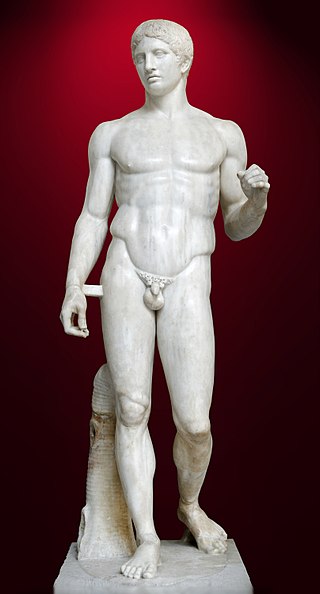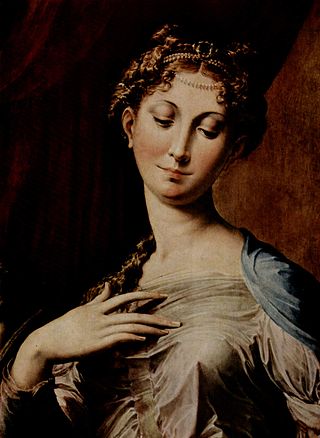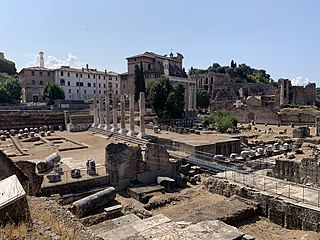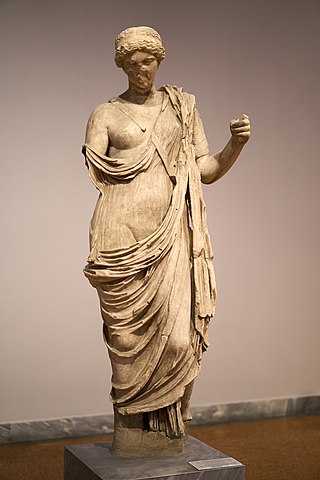
Contrapposto is an Italian term that means "counterpoise". It is used in the visual arts to describe a human figure standing with most of its weight on one foot, so that its shoulders and arms twist off-axis from the hips and legs in the axial plane.
This article concerns the period 459 BC – 450 BC.

Year 450 BC was a year of the pre-Julian Roman calendar. At the time, it was known as the Second year of the decemviri. The denomination 450 BC for this year has been used since the early medieval period, when the Anno Domini calendar era became the prevalent method in Europe for naming years.

Argos is a city and municipality in Argolis, Peloponnese, Greece and is one of the oldest continuously inhabited cities in the world, and one of oldest in Europe. It is the largest city in Argolis and a major center in the same prefecture, having nearly twice the population of the prefectural capital, Nafplio.
Myron of Eleutherae was an Athenian sculptor from the mid-5th century BC. He was born in Eleutherae on the borders of Boeotia and Attica. According to Natural History, a Latin encyclopedia by Pliny the Elder, a scholar in Ancient Rome, Ageladas of Argos was his teacher.

Polykleitos was an ancient Greek sculptor, active in the 5th century BCE. Alongside the Athenian sculptors Pheidias, Myron and Praxiteles, he is considered as one of the most important sculptors of classical antiquity. The 4th century BCE catalogue attributed to Xenocrates, which was Pliny's guide in matters of art, ranked him between Pheidias and Myron. He is particularly known for his lost treatise, the Canon of Polykleitos, which set out his mathematical basis of an idealised male body shape.
Polyclitus and its variants can refer to:

Lysippos was a Greek sculptor of the 4th century BC. Together with Scopas and Praxiteles, he is considered one of the three greatest sculptors of the Classical Greek era, bringing transition into the Hellenistic period. Problems confront the study of Lysippos because of the difficulty of identifying his style among the copies which survive. Not only did he have a large workshop and many disciples in his immediate circle, but there is understood to have been a market for replicas of his work, supplied from outside his circle, both in his lifetime and later in the Hellenistic and Roman periods. The Victorious Youth or Getty bronze, which resurfaced around 1972, has been associated with him.
The Greek Heroic Age, in mythology, is the period between the coming of the Greeks to Thessaly and the Greek warriors' return from Troy. The poet Hesiod identified this mythological era as one of his five Ages of Man. The period spans roughly six generations; the heroes denoted by the term are superhuman, though not divine, and are celebrated in the literature of Homer and of others, such as Sophocles, Aeschylus and Euripides.

Body proportions is the study of artistic anatomy, which attempts to explore the relation of the elements of the human body to each other and to the whole. These ratios are used in depictions of the human figure and may become part of an artistic canon of body proportion within a culture. Academic art of the nineteenth century demanded close adherence to these reference metrics and some artists in the early twentieth century rejected those constraints and consciously mutated them.

The Doryphoros of Polykleitos is one of the best known Greek sculptures of Classical antiquity, depicting a solidly built, muscular, standing warrior, originally bearing a spear balanced on his left shoulder. Rendered somewhat above life-size, the lost bronze original of the work would have been cast circa 440 BC, but it is today known only from later marble copies. The work nonetheless forms an important early example of both Classical Greek contrapposto and classical realism; as such, the iconic Doryphoros proved highly influential elsewhere in ancient art.

The Discobolus by Myron is an ancient Greek sculpture completed at the start of the Classical period in around 460–450 BC that depicts an ancient Greek athlete throwing a discus. Its Greek original in bronze lost, the work is known through numerous Roman copies, both full-scale ones in marble, which is cheaper than bronze, such as the Palombara Discobolus, the first to be recovered, and smaller scaled versions in bronze.
Kresilas was a Greek sculptor in the Classical period, from Kydonia. He was trained in Argos and then worked in Athens at the time of the Peloponnesian War, as a follower of the idealistic portraiture of Myron. He is best known for his statue Pericles with the Corinthian helmet.

The Temple of Peace, also known as the Forum of Vespasian, was built in Rome in 71 AD under Emperor Vespasian in honour to Pax, the Roman goddess of peace. It faces the Velian Hill, toward the famous Colosseum, and was on the southeast side of the Argiletum.
Phradmon was a little-known sculptor from Argos, whom Pliny places as the contemporary of Polykleitos, Myron, Pythagoras, Scopas, and Perelius, at Olympiad 90 in 420 BCE, in giving an anecdotal description of a competition for a Wounded Amazon for the temple of Artemis at Ephesus: in Pliny's anecdote, the fifth place was won by Phradmon, whom Pliny admits was younger than any of the four who were preferred to him. Trusting in Pliny's anecdote, scholars have often hopefully assigned the "Lansdowne" type of Wounded Amazon to Phradmon.

An artistic canon of body proportions, in the sphere of visual arts, is a formally codified set of criteria deemed mandatory for a particular artistic style of figurative art. The word canon was first used for this type of rule in Classical Greece, where it set a reference standard for body proportions, to produce a harmoniously formed figure appropriate to depict gods or kings. Other art styles have similar rules that apply particularly to the representation of royal or divine personalities.
Periclytus, a sculptor, who belonged to the best period and to one of the best schools of Greek art, but of whom scarcely any thing is known. He is only mentioned in a single passage of Pausanias, from which we learn that he was the disciple of Polykleitos, and the teacher of Antiphanes of Argos, who was the teacher of Cleon of Sicyon. Since Polycleitus flourished about b. c. 440, and Antiphanes about b. c. 400, the date of Periclytus may be fixed at about 420 BC.
Cleon was an Ancient Greek sculptor of Sicyon. He was a pupil of Antiphanes, who had been taught by Periclytus, a follower of the great Polykleitos of Argos.

Classical Greek sculpture has long been regarded as the highest point in the development of sculptural art in Ancient Greece, becoming almost synonymous with "Greek sculpture". The Canon, a treatise on the proportions of the human body written by Polykleitos around 450 B.C., is generally considered its starting point, and its end marked with the conquest of Greece by the Macedonians in 338 B.C., when Greek art began a great diffusion to the East, from where it received influences, changed its character, and became cosmopolitan. This phase is known as the Hellenistic period. In this period, the tradition of Greek Classicism was consolidated, with Man being the new measure of the universe.

Armed Aphrodite is a first-century AD Roman marble sculpture depicting Aphrodite Areia, or the war-like aspect of the Greek goddess Aphrodite, who was more commonly worshipped as a goddess of beauty and love. It is modelled after a lost Greek original of the fourth century BC made by Polykleitos the Younger, and is now kept in the National Archaeological Museum of Athens in Greece with accession number 262.










